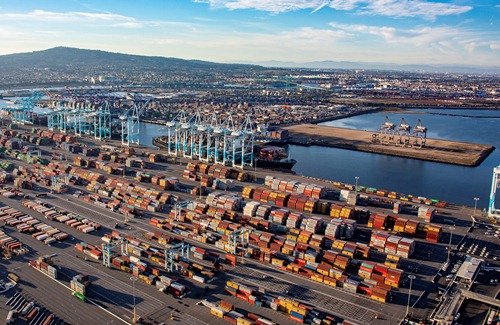-
Practically all ports in the US are under growing pressure to handle volumes that have broken pre-pandemic records every month for 11 months in a row
-
The Port of LA handled 536,000 loaded container imports in May, while Long Beach recorded 444,736 loaded TEUs coming in
-
Empty container exports leaving the two ports in May were at a record high of 693,583 TEUs
-
Port of LA executive director Gene Seroka expects the second half of the year to be equally strong as the port gears up for back-to-school season, fall fashion, as well as year-end holidays
The US West Coast ports of Los Angeles and Long Beach continue their record-breaking start to the year, exceeding pre-pandemic records again and again, adding to the pressure to catch up as the peak season starts.
The Baltic and International Maritime Council (BIMCO) said practically all ports in the US are already under growing pressure to handle volumes that have broken pre-pandemic records every month for 11 months in a row.
They “will have to continue to run fast to keep up, as peak season starts breathing down their necks,” BIMCO said in a new analysis.
In May, loaded imports and total throughput in both ports broke their previous highs. At the Port of LA, the busiest container port in the US, 535,714 loaded twenty foot equivalent units (TEUs) were imported, 75% higher year-on-year.
“It was the most imports ever in one month at the Port, eclipsing the previous record of 516,286 set in August of 2020,” said the LA port in a statement.
At the Port of Long Beach, 444,736 loaded TEUs came in last month, jumping 42.3% from May last year.
The two ports are responsible for over one-quarter of the total container trade in North America.
Empty container exports are also at a record high, with 693,583 TEUs leaving the two ports in May. At the Port of LA, empty containers climbed to 366,448 TEUs, a jump of 114% compared to last year due to the heavy demand in Asia and was the most empties ever processed in a month at the port.
The Port of Long Beach stated that it moved 327,135 TEUs of empty containers in May, an increase of 80.7% from the same month a year ago.
Empties exported by the two ports are “five and a half times more than the 122,951 TEUs loaded exports in the same month, driven by a combination of US exports not recovering as fast as imports, and carriers looking for a quick turnaround time to get boxes back to Asia,” said Peter Sand, BIMCO’s chief shipping analyst.
Gene Seroka, Port of Los Angeles executive director, in an online interview with Yahoo Finance, said “the strength of the US consumer continues greater than we’ve ever seen before. The imports for the month were at an all-time record of more than 535,000 container units.”
He also expects the second half of the year to be equally strong. “We’re going to be coming up on back to school season, fall fashion, as well as year-end holidays.”
In the first five months of this year, the two ports have recorded a total throughput of 8.6 million TEUs, a 45.3% increase from the 5.9 million TEUs handled in the first five months of 2020, but also up by 1.8 million TEUs (26.5%) from the start of 2019.
Before the pandemic, the highest throughput ever recorded by the two ports was 1.5 million TEUs, which was recorded in July 2019. That milestone has now been surpassed for 11 consecutive months.
“Another month of record high retail sales in the US in May—when looked at on an unadjusted basis—suggests that as the US economy re-opens and services become more widely available, US demand for goods remain strong. Retailers are currently struggling to keep up and the delays on getting their goods shipped continues to cause severe disruption to just-in-time supply chains,” said Sand.
“As long as consumer demand stays strong, the two ports in LA and others throughout the US, will continue to face massive amounts of pressure. Adding to this, with the traditional container shipping peak-season now fast approaching, the ports will have to continue to run fast if they are to stand any chance of keeping up.”
Photo from Port of Los Angeles website





